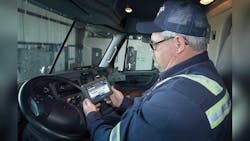NOW that the United States Court of Appeals for the Seventh Circuit has denied the Owner-Operator Independent Drivers Association’s (OOIDA) challenge, the Federal Motor Carrier Safety Administration’s (FMCSA) electronic logging device (ELD) final rule will take effect as scheduled.
Trucks must be equipped with ELDs by December 18, 2017, but vehicles that were equipped with compliant Automatic Onboard Recorders (AOBRDs) on December 16, 2015, receive a two-year extension to this deadline. The final ELD rule was published in late 2015 and requires that all trucks be equipped with electronic hours-of-service logging devices over a multi-year period.
Corporal DJ Danek, chairman of commercial vehicle enforcement for the Houston Council of Safety Professionals, addressed the key aspects in his presentation,
“ELD Rule, CSA Info, DOT Updates, Compliance, and Enforcement of Intermodal Liquid Carriers.” He discussed ELDs during the Intermodal Tank Container Association’s 2016 Intermodal Bulk Liquid Symposium in Kemah, Texas.
Danek said ELDs automatically record driving time, meet the requirements in the new Subpart B of Part 395, facilitate the accurate recording of drivers HOS, meet the technical specifications of the ELD rule, and are integrally synchronized with the engine of the CMV.
The elements recorded include: time; location information; engine hours; vehicle miles; driver/authenticated user; vehicle; and motor carrier.
Data is captured during change-of-duty status, intermediate recording (one per hour), special driving (personal or yard), certification of log, log in, log out, engine power-up, and a malfunction or data diagnostic event.
The ELD Record of Duty Status (RODS) must be shared in one of two ways during roadside inspections: a printout or a screen display that is visible to enforcement at a reasonable distance without entering the cab.
He said FMCSA has developed a standard by which roadside enforcement will examine the electronic HOS beyond the required screen display or in-cab printout. An enforcement application (to be developed by FMCSA) will receive raw data from the ELD. Raw data will be transferred to the inspector’s computer and all “required” information will be displayed.
ELD transfer methods can be through telematics (web services and email) or locally (Bluetooth or USB 2.0). The ELD provider determines the option, and enforcement determines which method within that option.
Right now, he said, there is voluntary use of AOBRDs or ELDs in a two-year awareness and transition phase until the compliance date of December 18, 2017.
“You can use whatever you’re using now until then, then you have to start changing,” he said. “If you’re not using AOBRDs, you have to start ELDs right away. Existing AOBRDs are grandfathered for two years. There is a two-year phased-in compliance schedule. There are approved ELD providers on an FMCSA list.”
When the full compliance date of December 16, 2019 arrives, ELD use will become mandatory.
“All drivers currently using RODS must comply unless exempted,” he said. “There is an exemption for short-haul drivers (100 air mile drivers). They may use paper logs up to eight days in any 30-day period. If a short-haul driver uses a paper log over eight days in a 30-day period, he must install an ELD. Other exemptions are for driveaway-towaway operations and commercial motor vehicles manufactured before model year 2000.”
He said the Texas Department of Public Safety adopted an ELD rule for intrastate operations—Texas ELD Rule 4.12. Between now and December 16, 2019, intrastate operations can use any one of the four RODS recording options: paper logs; electronic apps; AOBRDs; or ELDs. After that date, carriers must convert to ELDs unless they are able to claim an exception.
Danek also addressed FMCSA’s CSA (Compliance, Safety, Accountability program), SMS (Safety Measurement System), and PSP (Pre-Employment Screening Program).
“Some of your scores are public, and customers are looking at your scores,” Danek said. “A lot of carriers, customers, and brokers look at that. Your insurance company does. A lot of your insurance rates are generated from that.
“CSA can affect your company through decreased load rates—companies will go elsewhere because they’re looking for somebody safer—along with increased insurance rates, lowered credibility, and FMCSA intervention.”
FMCSA intervention involves early contact (extra inspections/warning letter), investigation (offsite investigation, onsite focused, onsite comprehensive), follow-up (corrective action plan, safety rating downgrade, notice of claim and fines, and out-of-service orders).
“That’s not for just one truck,” he said. “It’s for the whole company.”
Factors affecting CSA scores include: unsafe driving; crash indicator (not public); HOS compliance; vehicle maintenance; controlled substances and alcohol; hazardous materials compliance (not public); and driver fitness.
“One of the best ways to insure that you keep your CSA scores down is good pre-trip inspections,” he said. “Also, maintain your vehicles, maintain your maintenance/driver files, and have regular safety meetings with your drivers.”
He said the most common violation on intermodal bulk liquid operations is inoperable lights, followed by intermodal load securement (not secured in chassis), tire violations, shipping papers violations, and brakes. ♦
About the Author
Rick Weber
Associate Editor
Rick Weber has been an associate editor for Trailer/Body Builders since February 2000. A national award-winning sportswriter, he covered the Miami Dolphins for the Fort Myers News-Press following service with publications in California and Australia. He is a graduate of Penn State University.
